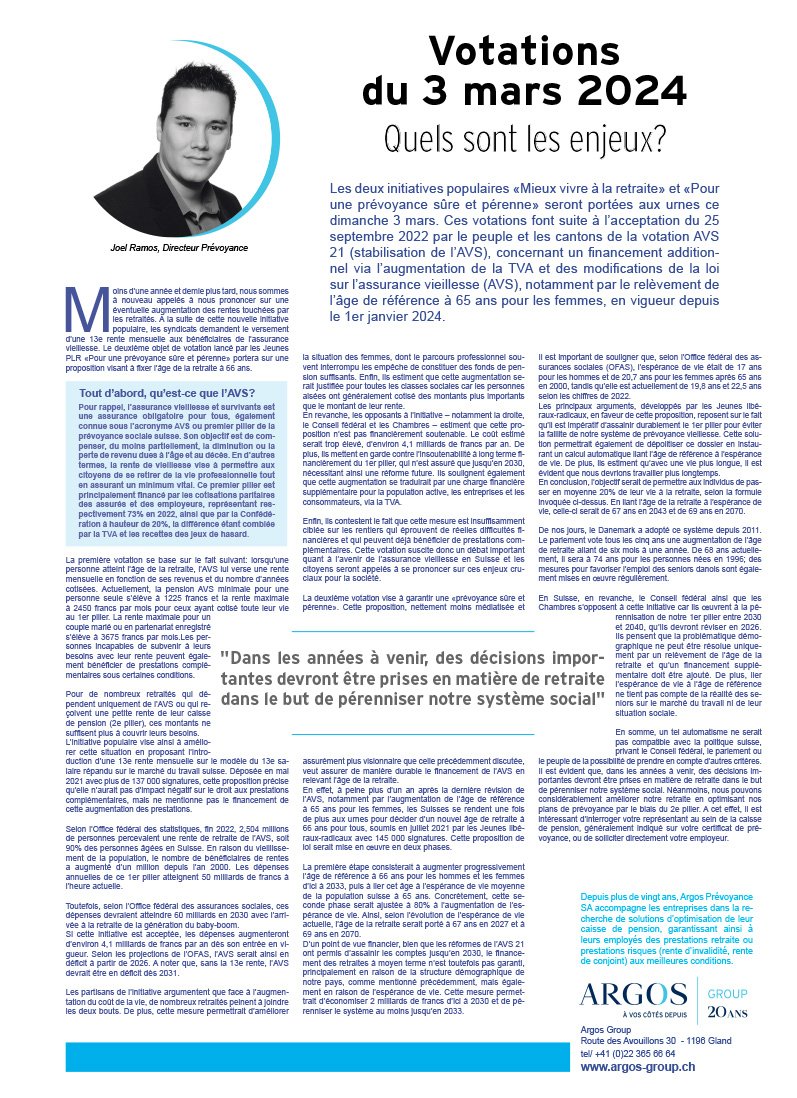Less than a year and a half later, we are once again called upon to vote on a possible increase in pensioners’ pensions. Following this new popular initiative, the trade unions are calling for a 13th monthly pension to be paid to beneficiaries of old-age insurance. The second ballot item launched by the Young PLR “Pour une prévoyance sûre et pérenne” (“For a secure and sustainable pension plan”) concerns a proposal to set the retirement age at 66.
First of all, what is AVS?
As a reminder, old-age and survivors’ insurance is compulsory for everyone, also known as AVS or the first pillar of Swiss social security. Its aim is to compensate, at least partially, for the reduction or loss of income due to age and death. In other words, the old-age pension is designed to enable people to retire from working life while ensuring a minimum standard of living. This first pillar is mainly financed by equal contributions from policyholders and employers, representing 73% respectively by 2022, and by the Confederation (20%), with the balance made up by VAT and gambling revenues.
Voting 1: “Better living in retirement
The first vote is based on the following fact: when a person reaches retirement age, the AHV pays them a monthly pension based on their income and the number of years they have contributed. At present, the minimum AVS pension for a single person is 1225 francs, and the maximum pension is 2450 francs per month for those who have contributed to the 1st pillar all their lives. The maximum pension for a married couple or a couple in a registered partnership is CHF 3,675 per month. People who are unable to support themselves on their pension may also qualify for supplementary benefits under certain conditions.
For many pensioners who depend solely on AHV or who receive a small pension from their pension fund (2nd pillar), these amounts are no longer sufficient to cover their needs. The popular initiative therefore aims to improve this situation by proposing the introduction of a 13th monthly pension on the model of the 13th salary widespread on the Swiss labor market. Submitted in May 2021 with over 137,000 signatures, this proposal states that it would have no negative impact on entitlement to supplementary benefits, but makes no mention of how this increase in benefits would be financed.
According to the Swiss Federal Statistical Office, by the end of 2022, 2.504 million people will be receiving an AHV retirement pension, representing 90% of all elderly people in Switzerland. Due to the aging of the population, the number of pensioners has risen by one million since 2000. Annual expenditure on this 1st pillar currently stands at CHF 50 billion.
However, according to the Federal Social Insurance Office, this expenditure is set to rise to 60 billion by 2030 as the baby-boom generation retires. If the initiative is accepted, spending will increase by around CHF 4.1 billion a year once it comes into force. According to OFAS projections, the AHV will be in deficit from 2026 onwards. Without the 13th pension, the AHV would be in deficit from 2031.
Supporters of the initiative point out that, with the rising cost of living, many pensioners are struggling to make ends meet. In addition, this measure would improve the situation of women, whose often interrupted career paths prevent them from building up sufficient pension funds. Finally, they believe that this increase would be justified for all social classes, as wealthy people have generally contributed larger amounts than their pensions.
On the other hand, the initiative’s opponents – notably the right, the Federal Council and the Chambers of Parliament – consider the proposal to be financially unsustainable. The estimated cost would be too high, at around CHF 4.1 billion a year. In addition, they warn that the 1st pillar is financially unsustainable in the long term, as it is only insured until 2030, necessitating future reform. They also point out that this increase would result in an additional financial burden for the working population, companies and consumers, via VAT.
Finally, they contest the fact that this measure is insufficiently targeted at pensioners who are experiencing real financial difficulties and who are already eligible for supplementary benefits. This vote will therefore give rise to an important debate on the future of old-age insurance in Switzerland, and citizens will be called upon to express their views on these crucial issues for society.
Votation 2: “For a safe and sustainable pension plan”.
The second vote is aimed at guaranteeing a ” secure and sustainable pension plan”. This proposal, much less publicized and certainly more visionary than the one previously discussed, aims to ensure sustainable financing of the AHV by raising the retirement age.
Barely more than a year after the last revision of the AHV, notably by raising the reference age to 65 for women, the Swiss are once again going to the polls to decide on a new retirement age of 66 for all, submitted in July 2021 by the Young Liberal-Radicals with 145,000 signatures. The bill would be implemented in two phases.
- The first step would be to gradually increase the reference age to 66 for both men and women by 2033.
- Secondly, this age would be linked to the average life expectancy of the Swiss population at age 65. In concrete terms, this second phase would be adjusted to 80% of the increase in life expectancy.
Thus, based on current life expectancy trends, the retirement age would rise to 67 in 2027 and 69 in 2070.
From a financial point of view, although the AVS 21 reforms have put the accounts on a sounder footing until 2030, pension funding in the medium term is not guaranteed, mainly due to the demographic structure of our country, as mentioned above, but also to life expectancy. This measure would save CHF 2 billion between now and 2030, making the system sustainable until at least 2033.
It is important to note that, according to the Federal Social Insurance Office (FSIO), life expectancy was 17 years for men and 20.7 years for women after the age of 65 in 2000, whereas it is currently 19.8 years and 22.5 years according to figures for 2022.
The main arguments put forward by the Young Liberal-Radicals in favor of this proposal are based on the fact that it is imperative to put the 1st pillar on a sustainable footing to avoid the bankruptcy of our pension system. This solution would also depoliticize the issue by introducing an automatic calculation linking the reference age to life expectancy. What’s more, they believe that, with longer life expectancy, it’s obvious that we should be working longer. In conclusion, the aim would be to enable individuals to spend an average of 20% of their lives in retirement, according to the formula invoked above. By linking retirement age to life expectancy, the latter would be 67 in 2043 and 69 in 2070. Denmark adopted this system in 2011. Every five years, parliament votes to increase the retirement age by six months to one year. From 68 at present, it will rise to 74 for people born in 1996; measures to encourage the employment of Danish seniors are also regularly implemented.
In Switzerland, on the other hand, the Federal Council and Parliament are opposed to this initiative, as they are working to ensure the sustainability of our 1st pillar between 2030 and 2040, which they will have to revise in 2026. They believe that the demographic problem cannot be solved by raising the retirement age alone, and that additional funding must be added. Furthermore, linking life expectancy to the reference age does not take into account the reality of older people in the labor market, nor their social situation.
In short, such an automatic system would not be compatible with Swiss policy, depriving the Federal Council, Parliament or the people of the possibility of taking other criteria into account.
Clearly, in the years to come, major decisions will have to be taken on pensions to ensure the long-term future of our social system.
Nevertheless, we can considerably improve our retirement by optimizing our pension plans through the 2nd pillar. It’s a good idea to ask your pension fund representative, who is usually listed on your pension certificate, or your employer directly.
For over twenty years, Argos Prévoyance SA has been helping companies find solutions to optimize their pension funds, guaranteeing their employees retirement benefits or risk benefits (disability pension, spouse’s pension) on the best possible terms.
Joel Ramos – Director of Pensions.
Edited in collaboration with the magazine “Le Temps”, find the complete newspaper here:









